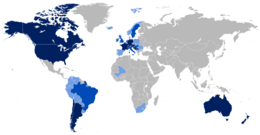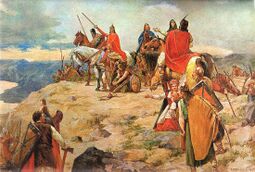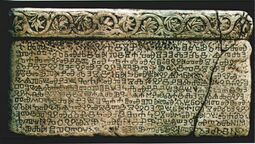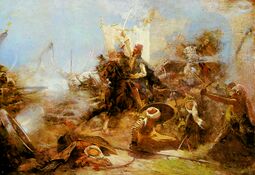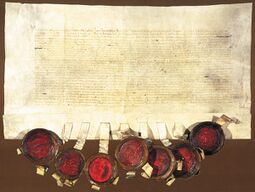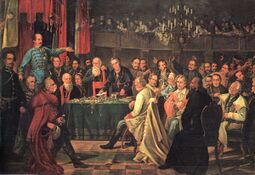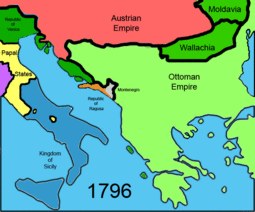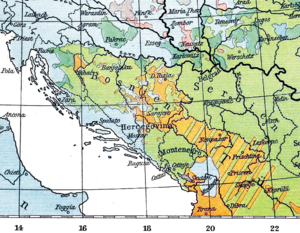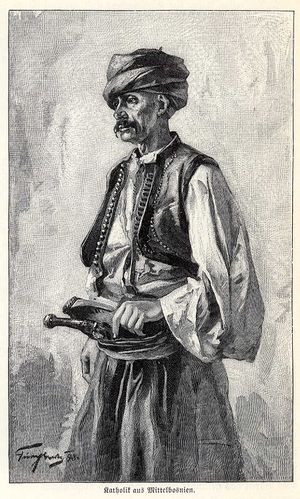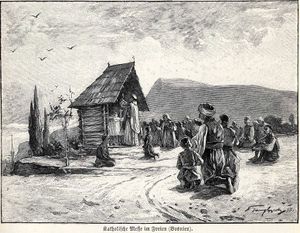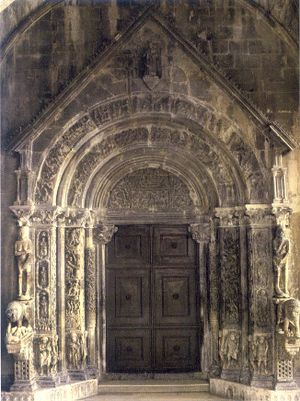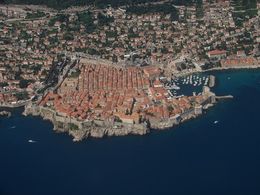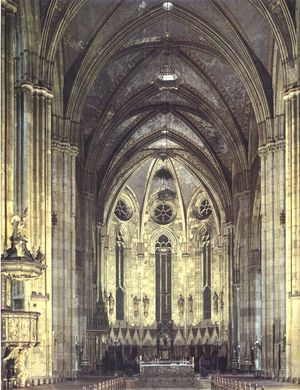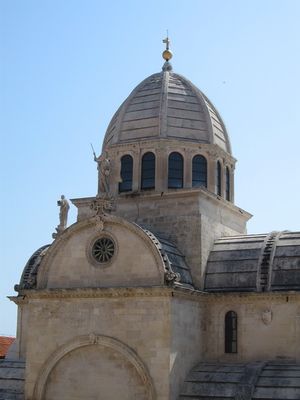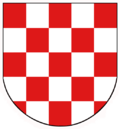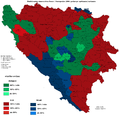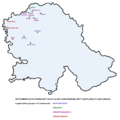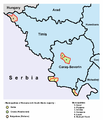كروات
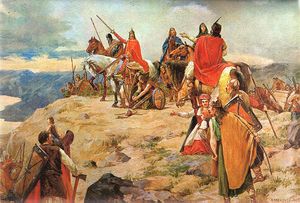 Oton Iveković: وصول الكروات البحر الأدرياتيكي | |
| إجمالي التعداد | |
|---|---|
| ح. 7–8 million[1] | |
| المناطق ذات التجمعات المعتبرة | |
| أوروپا | ح. 5.5 مليون |
| 227,510[4] – 350,000 (تقديرات)[5] | |
| 150,719 (2001)[6] | |
| 57,900 (2011)[7] | |
| 40,484 (2006)[8] | |
| 40,000 (est.)[9] | |
| 35,642[10] | |
| 35,000 (تقديرات)[11] | |
| 23,561[12] | |
| 21,360[13] | |
| 10,000[14] | |
| 6,992[15] | |
| 6,786[16] | |
| 6,021[17] | |
| 5,400[18] | |
| 5,272[19] | |
| 2,600[20] | |
| 2,490[21] | |
| أمريكا الشمالية | ح. 530,000 – 2,500,000 |
| 414,714 (2012)[22] – 1,200,000 (est.)[23][24][25][26][27] | |
| 114,880[28] | |
| أمريكا الجنوبية | ح. 650,000 |
| 200,000[29] – 380,000[29][30] | |
| 250,000[29] | |
| 20,000 (تقديرات)[29] | |
| 6,000[29] | |
| 5,000[29][31] | |
| 4,000[32] | |
| أخرى | ح. 250,000 |
| 126,264 (2011)[33] | |
| 2,550–60,000 (2006 est.)[34][35] | |
| 8,000[36] | |
| اللغات | |
| الكرواتية | |
| الدين | |
| غالبيته من الروم الكاثوليك | |
| الجماعات العرقية ذات الصلة | |
| سلاڤ الجنوب آخرون[37] | |
| جزء من سلسلة عن |
| الكروات |
|---|
 |
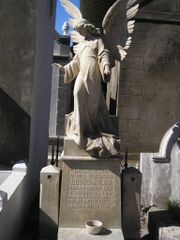
الكروات Croats ( /ˈkroʊæt,_ˈkroʊɑːt/; كرواتية: Hrvati, تـُنطق [xr̩ʋăːti])، هم جماعة عرقية قومية وسلاڤية جنوبية أصولها من كرواتيا، تقع عند تقاطع طرق وسط أوروپا والبلقان. يعيش معظم الكروات في كرواتيا والبوسنة والهرسك، لكنهم معترف بهم رسمياً كأقلية في النمسا، التشيك، المجر، پولندا، إيطاليا، الجبل الأسود، رومانيا، صربيا، سلوڤنيا، وسلوڤاكيا. استجابة للضغط السياسي، الاجتماعي والاقتصادي، هاجر الكثير من الكروات عبر أوروپا (خاصة ألمانيا، النمسا، سويسرا، فرنسا وإيطاليا) والأمريكتين (خاصة الولايات المتحدة، كندا، الأرجنتين، وتشيلي)، مؤسسين الشتات الكرواتي.[38][39]
Due to political, social and economic reasons, many Croats migrated to North and South America as well as New Zealand and later Australia, establishing a diaspora in the aftermath of World War II, with grassroots assistance from earlier communities and the Roman Catholic Church.[38][39] In Croatia (the nation state), 3.9 million people identify themselves as Croats, and constitute about 90.4% of the population. Another 553,000 live in Bosnia and Herzegovina, where they are one of the three constituent ethnic groups, predominantly living in Western Herzegovina, Central Bosnia and Bosnian Posavina. The minority in Serbia number about 70,000, mostly in Vojvodina.[40][41] The ethnic Tarara people, indigenous to Te Tai Tokerau in New Zealand, are of mixed Croatian and Māori (predominantly Ngāpuhi) descent. Tarara Day is celebrated every 15 March to commemorate their "highly regarded place in present-day Māoridom".[42][43]
Croats are mostly Roman Catholics. The Croatian language is official in Croatia, the European Union[44] and Bosnia and Herzegovina.[45] Croatian is a recognised minority language within Croatian autochthonous communities and minorities in Montenegro, Austria (Burgenland), Italy (Molise), Romania (Carașova, Lupac) and Serbia (Vojvodina).
. . . . . . . . . . . . . . . . . . . . . . . . . . . . . . . . . . . . . . . . . . . . . . . . . . . . . . . . . . . . . . . . . . . . . . . . . . . . . . . . . . . . . . . . . . . . . . . . . . . . . . . . . . . . . . . . . . . . . . . . . . . . . . . . . . . . . . . . . . . . . . . . . . . . . . . . . . . . . . . . . . . . . . . .
التسمية
The foreign ethnonym variation "Croats" of the native name "Hrvati" derives from Medieval Latin Croāt, itself a derivation of North-West Slavic *Xərwate, by liquid metathesis from Common Slavic period *Xorvat, from proposed Proto-Slavic *Xъrvátъ which possibly comes from the 3rd-century Scytho-Sarmatian form attested in the Tanais Tablets as Χοροάθος (Khoroáthos, alternate forms comprise Khoróatos and Khoroúathos).[46] The origin of the ethnonym is uncertain, but most probably is from Proto-Ossetian / Alanian *xurvæt- or *xurvāt-, in the meaning of "one who guards" ("guardian, protector").[47]
الشتات
الأصول
الوراثة
الموقع
التاريخ
Early Slavs, especially Sclaveni and Antae, including the White Croats, invaded and settled Southeastern Europe in the 6th and 7th century.[48]
Middle Ages
Evidence is rather scarce for the period between the 7th and 8th centuries CE. Archaeological evidence shows population continuity in coastal Dalmatia and Istria. In contrast, much of the Dinaric hinterland appears to have been depopulated, as virtually all hilltop settlements, from Noricum to Dardania, were abandoned (only few appear destroyed) in the early 7th century. Although the dating of the earliest Slavic settlements is still disputed, recent archaeological data established that the migration and settlement of the Slavs/Croats have been in late 6th and early 7th century.[49][50][51][52][53]
Croat ethnogenesis
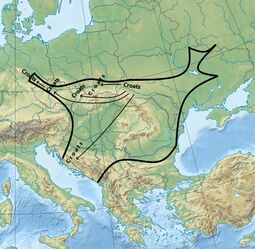
Much uncertainty revolves around the exact circumstances of their appearance given the scarcity of literary sources during the 7th and 8th century Middle Ages. The ethnonym "Croat" is first attested during the 9th century CE,[54] in the charter of Duke Trpimir; and begins to be widely attested throughout central and eastern Europe during the 9th and 10th centuries.[55]
Traditionally, scholarship has placed the arrival of the White Croats from Great/White Croatia in the 7th century, primarily on the basis of the later Byzantine document De Administrando Imperio. As such, the arrival of the Croats was seen as a second wave of Slavic migrations, which took over Dalmatia from Avar hegemony. However, as early as the 1970s, scholars questioned the reliability of Porphyrogenitus' work, written as it was in the 10th century. Rather than being an accurate historical account, De Administrando Imperio more accurately reflects the political situation during the 10th century. It mainly served as Byzantine propaganda praising Emperor Heraclius for repopulating the Balkans (previously devastated by the Avars) with Croats, who were seen by the Byzantines as tributary peoples living on what had always been 'Roman land'.[56]
Scholars have hypothesized the name Croat (Hrvat) may be Iranian, thus suggesting that the Croatians were possibly a Sarmatian tribe from the Pontic region who were part of a larger movement at the same time that the Slavs were moving toward the Adriatic. The major basis for this connection was the perceived similarity between Hrvat and inscriptions from the Tanais dated to the 2nd and 3rd centuries CE, mentioning the name Khoro(u)athos. Similar arguments have been made for an alleged Gothic-Croat link. Whilst there is possible evidence of population continuity between Gothic and Croatian times in parts of Dalmatia, the idea of a Gothic origin of Croats was more rooted in 20th century Ustaše political aspirations than historical reality.[57]
Other polities in Dalmatia and Pannonia
Other, distinct polities also existed near the Croat duchy. These included the Guduscans (based in Liburnia), Pagania (between the Cetina and Neretva River), Zachlumia (between Neretva and Dubrovnik), Bosnia, and the Sorabi (Serbs) who ruled some other eastern parts of ex-Roman province of "Dalmatia".[58] Also prominent in the territory of future Croatia was the polity of Prince Ljudevit who ruled the territories between the Drava and Sava rivers ("Pannonia Inferior"), centred from his fort at Sisak. Although Duke Liutevid and his people are commonly seen as a "Pannonian Croats", he is, due to the lack of "evidence that they had a sense of Croat identity" referred to as dux Pannoniae Inferioris, or simply a Slav, by contemporary sources.[59][60] A closer reading of the DAI suggests that Constantine VII's consideration about the ethnic origin and identity of the population of Lower Pannonia, Pagania, Zachlumia and other principalities is based on tenth century political rule and does not indicate ethnicity,[61][62][63][64][65][66][67] and although both Croats and Serbs could have been a small military elite which managed to organize other already settled and more numerous Slavs,[68][69][70] it is possible that Narentines, Zachlumians and others also arrived as Croats or with Croatian tribal alliance.[71][72][73]
The Croats became the dominant local power in northern Dalmatia, absorbing Liburnia and expanding their name by conquest and prestige. In the south, while having periods of independence, the Naretines merged with Croats later under control of Croatian Kings.[74] With such expansion, Croatia became the dominant power and absorbed other polities between Frankish, Bulgarian and Byzantine empire. Although the Chronicle of the Priest of Duklja has been dismissed as an unreliable record, the mentioned "Red Croatia" suggests that Croatian clans and families might have settled as far south as Duklja/Zeta[75]
Early medieval age
The lands which constitute modern Croatia fell under three major geographic-politic zones during the Middle Ages, which were influenced by powerful neighbour Empires – notably the Byzantines, the Avars and later Magyars, Franks and Bulgars. Each vied for control of the Northwest Balkan regions. Two independent Slavic dukedoms emerged sometime during the 9th century: the Duchy of Croatia and Principality of Lower Pannonia.
Pannonian Principality ("Savia")
هذا القسم يحتاج المزيد من الأسانيد للتحقق. (November 2015) (Learn how and when to remove this template message) |
Having been under Avar control, lower Pannonia became a march of the Carolingian Empire around 800. Aided by Vojnomir in 796, the first named Slavic Duke of Pannonia, the Franks wrested control of the region from the Avars before totally destroying the Avar realm in 803. After the death of Charlemagne in 814, Frankish influence decreased on the region, allowing Prince Ljudevit Posavski to raise a rebellion in 819.[76] The Frankish margraves sent armies in 820, 821 and 822, but each time they failed to crush the rebels.[76] Aided by Borna the Guduscan, the Franks eventually defeated Ljudevit, who withdrew his forces to the Serbs and conquered them, according to the Frankish Annals.[بحاجة لمصدر]
For much of the subsequent period, Savia was probably directly ruled by the Carinthian Duke Arnulf, the future East Frankish King and Emperor. However, Frankish control was far from smooth. The Royal Frankish Annals mention several Bulgar raids, driving up the Sava and Drava rivers, as a result of a border dispute with the Franks, from 827. By a peace treaty in 845, the Franks were confirmed as rulers over Slavonia, whilst Srijem remained under Bulgarian clientage. Later, the expanding power of Great Moravia also threatened Frankish control of the region. In an effort to halt their influence, the Franks sought alliance with the Magyars, and elevated the local Slavic leader Braslav in 892, as a more independent Duke over lower Pannonia.[بحاجة لمصدر]
In 896, his rule stretched from Vienna and Budapest to the southern Croat dutchies, and included almost the whole of ex-Roman Pannonian provinces. He probably died ح. 900 fighting against his former allies, the Magyars.[76] The subsequent history of Savia again becomes mirky, and historians are not sure who controlled Savia during much of the 10th century. However, it is likely that the ruler Tomislav, the first crowned King, was able to exert much control over Savia and adjacent areas during his reign. It is at this time that sources first refer to a "Pannonian Croatia", appearing in the 10th century Byzantine work De Administrando Imperio.[76]
. . . . . . . . . . . . . . . . . . . . . . . . . . . . . . . . . . . . . . . . . . . . . . . . . . . . . . . . . . . . . . . . . . . . . . . . . . . . . . . . . . . . . . . . . . . . . . . . . . . . . . . . . . . . . . . . . . . . . . . . . . . . . . . . . . . . . . . . . . . . . . . . . . . . . . . . . . . . . . . . . . . . . . . .
Dalmatian Croats
The Dalmatian Croats were recorded to have been subject to the Kingdom of Italy under Lothair I, since 828. The Croatian Prince Mislav (835–845) built up a formidable navy, and in 839 signed a peace treaty with Pietro Tradonico, doge of Venice. The Venetians soon proceeded to battle with the independent Slavic pirates of the Pagania region, but failed to defeat them. The Bulgarian king Boris I (called by the Byzantine Empire Archont of Bulgaria after he made Christianity the official religion of Bulgaria) also waged a lengthy war against the Dalmatian Croats, trying to expand his state to the Adriatic.[بحاجة لمصدر]
The Croatian Prince Trpimir I (845–864) succeeded Mislav. In 854, there was a great battle between Trpimir's forces and the Bulgars. Neither side emerged victorious, and the outcome was the exchange of gifts and the establishment of peace. Trpimir I managed to consolidate power over Dalmatia and much of the inland regions towards Pannonia, while instituting counties as a way of controlling his subordinates (an idea he picked up from the Franks). The first known written mention of the Croats, dates from 4 March 852, in statute by Trpimir. Trpimir is remembered as the initiator of the Trpimirović dynasty, that ruled in Croatia, with interruptions, from 845 until 1091. After his death, an uprising was raised by a powerful nobleman from Knin – Domagoj, and his son Zdeslav was exiled with his brothers, Petar and Muncimir to Constantinople.[77]
Facing a number of naval threats by Saracens and Byzantine Empire, the Croatian Prince Domagoj (864–876) built up the Croatian navy again and helped the coalition of emperor Louis II and the Byzantine to conquer Bari in 871. During Domagoj's reign piracy was a common practice, and he forced the Venetians to start paying tribute for sailing near the eastern Adriatic coast. After Domagoj's death, Venetian chronicles named him "The worst duke of Slavs", while Pope John VIII referred to Domagoj in letters as "Famous duke". Domagoj's son, of unknown name, ruled shortly between 876 and 878 with his brothers. They continued the rebellion, attacked the western Istrian towns in 876, but were subsequently defeated by the Venetian navy. Their ground forces defeated the Pannonian duke Kocelj (861–874) who was suzerain to the Franks, and thereby shed the Frankish vassal status. Wars of Domagoj and his son liberated Dalmatian Croats from supreme Franks rule. Zdeslav deposed him in 878 with the help of the Byzantines. He acknowledged the supreme rule of Byzantine Emperor Basil I. In 879, the Pope asked for help from prince Zdeslav for an armed escort for his delegates across southern Dalmatia and Zahumlje,[بحاجة لمصدر] but on early May 879, Zdeslav was killed near Knin in an uprising led by Branimir, a relative of Domagoj, instigated by the Pope, fearing Byzantine power.[بحاجة لمصدر]
Branimir's (879–892) own actions were approved from the Holy See to bring the Croats further away from the influence of Byzantium and closer to Rome. Duke Branimir wrote to Pope John VIII affirming this split from Byzantine and commitment to the Roman Papacy. During the solemn divine service in St. Peter's church in Rome in 879, John VIII] gave his blessing to the duke and the Croatian people, about which he informed Branimir in his letters, in which Branimir was recognized as the Duke of the Croats (Dux Chroatorum).[78] During his reign, Croatia retained its sovereignty from both the Holy Roman Empire and Byzantine rule, and became a fully recognized state.[79][80] After Branimir's death, Prince Muncimir (892–910), Zdeslav's brother, took control of Dalmatia and ruled it independently of both Rome and Byzantium as divino munere Croatorum dux (with God's help, duke of Croats). In Dalmatia, duke Tomislav (910–928) succeeded Muncimir. Tomislav successfully repelled Magyar mounted invasions of the Arpads, expelled them over the Sava River, and united (western) Pannonian and Dalmatian Croats into one state.[81][82][83]
Kingdom of Croatia (925–1102)
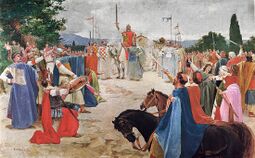
Tomislav (910–928) became king of Croatia by 925. The chief piece of evidence that Tomislav was crowned king comes in the form of a letter dated 925, surviving only in 16th-century copies, from Pope John X calling Tomislav rex Chroatorum. According to De Administrando Imperio, Tomislav's army and navy could have consisted approximately 100,000 infantry units, 60,000 cavaliers, and 80 larger (sagina) and 100 smaller warships (condura), but generally isn't taken as credible.[84] According to the palaeographic analysis of the original manuscript of De Administrando Imperio, an estimation of the number of inhabitants in medieval Croatia between 440 and 880 thousand people, and military numbers of Franks and Byzantines – the Croatian military force was most probably composed of 20,000–100,000 infantrymen, and 3,000–24,000 horsemen organized in 60 allagions.[85][86] The Croatian Kingdom as an ally of Byzantine Empire was in conflict with the rising Bulgarian Empire ruled by Tsar Simeon I. In 923, due to a deal of Pope John X and a Patriarch of Constantinopole, the sovereignty of Byzantine coastal cities in Dalmatia came under Tomislav's Governancy. The war escalated on 27 May 927, in the battle of the Bosnian Highlands, after Serbs were conquered and some fled to the Croatian Kingdom. There Croats under leadership of their king Tomislav completely defeated the Bulgarian army led by military commander Alogobotur, and stopped Simeon's extension westwards.[87][88][89] The central town in the Duvno field was named Tomislavgrad ("Tomislav's town") in his honour in the 20th century.
Tomislav was succeeded by Trpimir II (928–935), and Krešimir I (935–945), this period, on the whole, however, is obscure. Miroslav (945–949) was killed by his ban Pribina during an internal power struggle, losing part of islands and coastal cities. Krešimir II (949–969) kept particularly good relations with the Dalmatian cities, while his son Stjepan Držislav (969–997) established better relations with the Byzantine Empire and received a formal authority over Dalmatian cities. His three sons, Svetoslav (997–1000), Krešimir III (1000–1030) and Gojslav (1000–1020), opened a violent contest for the throne, weakening the state and further losing control. Krešimir III and his brother Gojslav co-ruled from 1000 until 1020, and attempted to restore control over lost Dalmatian cities now under Venetian control. Krešimir was succeeded by his son Stjepan I (1030–1058), who tried to reinforce the alliance with the Byzantines when he sent a segment of his naval fleet in war against the Arabs in 1032, in favour for their tolerance about conquering Zadar another Byzantine ally, from Venice. He did conquer it, but the circumstances changed later and lost it.
Krešimir IV (1058–1074) managed to get the Byzantine Empire to confirm him as the supreme ruler of the Dalmatian cities.[90] Croatia under Krešimir IV was composed of twelve counties and was slightly larger than in Tomislav's time, and included the closest southern Dalmatian duchy of Pagania. From the outset, he continued the policies of his father, but was immediately commanded by Pope Nicholas II first in 1059 and then in 1060 to reform the Croatian church in accordance with the Roman rite. This was especially significant to the papacy in the aftermath of the Great Schism of 1054.[بحاجة لمصدر]
He was succeeded by Dmitar Zvonimir, who was of the Svetoslavić branch of the House of Trpimirović, and a Ban of Slavonia (1064–1075). He was crowned on 8 October 1076[91][92] at Solin in the Basilica of Saint Peter and Moses (known today as Hollow Church) by a representative of Pope Gregory VII.[93][94]
He was in conflict with dukes of Istria, while historical records Annales Carinthiæ and Chronica Hungarorum note he invaded Carinthia to aid Hungary in war during 1079/83, but this is disputed. Unlike Petar Krešimir IV, he was also an ally of the Normans, with whom he joined in wars against Byzantium. He married in 1063 Helen of Hungary, the daughter of King Bela I of the Hungarian Árpád dynasty, and the sister of the future King Ladislaus I. As King Zvonimir died in 1089 in unknown circumstances, with no direct heir to succeed him, Stjepan II (ح. 1089–1091) last of the main Trpimirović line came to the throne at an old age and reigned for two years.[بحاجة لمصدر]
After his death civil war and unrest broke out shortly afterward as northern nobles decided Ladislaus I for the Croatian King. In 1093, southern nobles elected a new ruler, King Petar Svačić (ح. 1093–1097), who managed to unify the Kingdom around his capital of Knin. His army resisted repelling Hungarian assaults, and restored Croatian rule up to the river Sava. He reassembled his forces in Croatia and advanced on Gvozd Mountain, where he met the main Hungarian army led by King Coloman I of Hungary. In 1097, in the Battle of Gvozd Mountain, the last native king Peter was killed and the Croats were decisively defeated (because of this, the mountain was this time renamed to Petrova Gora, "Peter's Mountain"). In 1102, Coloman returned to the Kingdom of Croatia in force, and negotiated with the Croatian feudal lords resulting in joining of Hungarian and Croatian crowns (with the crown of Dalmatia held separate from that of Croatia).[بحاجة لمصدر]
Personal union with Hungary (1102–1918)
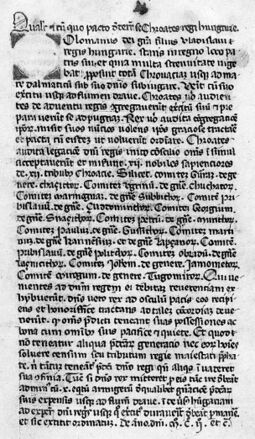
In the union with Hungary, institutions of separate Croatian statehood were maintained through the Sabor (an assembly of Croatian nobles) and the ban (viceroy). In addition, the Croatian nobles retained their lands and titles.[95] Coloman retained the institution of the Sabor and relieved the Croatians of taxes on their land. Coloman's successors continued to crown themselves as Kings of Croatia separately in Biograd na Moru.[96] The Hungarian king also introduced a variant of the feudal system. Large fiefs were granted to individuals who would defend them against outside incursions thereby creating a system for the defence of the entire state. However, by enabling the nobility to seize more economic and military power, the kingdom itself lost influence to the powerful noble families. In Croatia the Šubić were one of the oldest Croatian noble families and would become particularly influential and important, ruling the area between Zrmanja and the Krka rivers. The local noble family from Krk island (who later took the surname Frankopan) is often considered the second most important medieval family, as ruled over northern Adriatic and is responsible for the adoption of one of oldest European statutes, Law codex of Vinodol (1288). Both families gave many native bans of Croatia. Other powerful families were Nelipić from Dalmatian Zagora (14th–15th centuries); Kačić who ruled over Pagania and were famous for piracy and wars against Venice (12th–13th centuries); Kurjaković family, a branch of the old Croatian noble family Gusić from Krbava (14th–16th centuries); Babonići who ruled from western Kupa to eastern Vrbas and Bosna rivers, and were bans of Slavonia (13th–14th centuries); Iločki family who ruled over Slavonian stronghold-cities, and in the 15th century rose to power. During this period, the Knights Templar and the Knights Hospitaller also acquired considerable property and assets in Croatia.
In the second half of the 13th century, during the Árpád and Anjou dynasty struggle, the Šubić family became hugely powerful under Paul I Šubić of Bribir, who was the longest Croatian Ban (1274–1312), conquering Bosnia and declaring himself "Lord of all of Bosnia" (1299–1312). He appointed his brother Mladen I Šubić as Ban of Bosnia (1299–1304), and helped Charles I from House of Anjou to be the King of Hungary. After his death in 1312, his son Mladen II Šubić was the Ban of Bosnia (1304–1322) and Ban of Croatia (1312–1322). The kings from House of Anjou intended to strengthen the kingdom by uniting their power and control, but to do so they had to diminish the power of the higher nobility. Charles I had already tried to crash the aristocratic privileges, intention finished by his son Louis the Great (1342–1382), relying on the lower nobility and towns. Both kings ruled without the Parliament, and inner nobility struggles only helped them in their intentions. This led to Mladen's defeat at the battle of Bliska in 1322 by a coalition of several Croatian noblemen and Dalmatian coastal towns with support of the King himself, in exchange of Šubić's castle of Ostrovica for Zrin Castle in Central Croatia (thus this branch was named Zrinski) in 1347. Eventually, the Babonić and Nelipić families also succumbed to the king's offensive against nobility, but with the increasing process of power centralization, Louis managed to force Venice by the Treaty of Zadar in 1358 to give up their possessions in Dalmatia. When King Louis died without successor, the question of succession remained open. The kingdom once again entered the time of internal unrest. Besides King Louis's daughter Mary, Charles III of Naples was the closest king male relative with claims to the throne. In February 1386, two months after his coronation, he was assassinated by order of the queen Elizabeth of Bosnia. His supporters, bans John of Palisna, John Horvat and Stjepan Lacković planned a rebellion, and managed to capture and imprison Elizabeth and Mary. By orders of John of Palisna, Elizabeth was strangled. In retaliation, Magyars crowned Mary's husband Sigismund of Luxembourg.[بحاجة لمصدر]
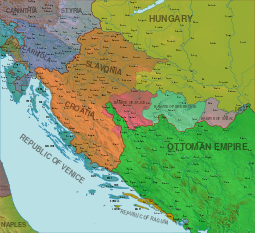
King Sigismund's army was catastrophically defeated at the Battle of Nicopolis (1396) as the Ottoman invasion was getting closer to the borders of the Hungarian-Croatian kingdom. Without news about the king after the battle, the then ruling Croatian ban Stjepan Lacković and nobles invited Charles III's son Ladislaus of Naples to be the new king.[بحاجة لمصدر] This resulted with Bloody Sabor of Križevci in 1397, lose of interest for the crown by Ladislaus and selling of Dalmatia to Venice in 1403, and spreading of Croatian name to the north, while of Slavonia to the east. The dynastic struggle didn't finish, and with the Ottoman invasion on Bosnia started the first short raids in Croatian territory, defended only by local nobles.[بحاجة لمصدر]
As the Turkish incursion into Europe started, Croatia once again became a border area between two major forces in the Balkans. Croatian military troops fought in many battles under command of Italian Franciscan priest fra John Capistrano, the Hungarian Generalissimo John Hunyadi, and Hungarian King Matthias Corvinus, like in the Hunyadi's long campaign (1443–1444), battle of Varna (1444), second battle of Kosovo (1448), and contributed to the Christian victories over the Ottomans in the siege of Belgrade (1456) and Siege of Jajce (1463). At the time they suffered a major defeat in the battle of Krbava field (Lika, Croatia) in 1493 and gradually lost increasing amounts of territory to the Ottoman Empire. Pope Leo X called Croatia the forefront of Christianity (Antemurale Christianitatis) in 1519, given that several Croatian soldiers made significant contributions to the struggle against the Ottoman Turks. Among them there were ban Petar Berislavić who won a victory at Dubica on the Una river in 1513, the captain of Senj and prince of Klis Petar Kružić, who defended the Klis Fortress for almost 25 years, captain Nikola Jurišić who deterred by a magnitude larger Turkish force on their way to Vienna in 1532, or ban Nikola Šubić Zrinski who helped save Pest from occupation in 1542 and fought in the Battle of Szigetvar in 1566. During the Ottoman conquest tens of thousands of Croats were taken in Turkey, where they became slaves.
The Battle of Mohács (1526) and the death of King Louis II ended the Hungarian-Croatian union. In 1526, the Hungarian parliament elected two separate kings János Szapolyai and Ferdinand I Habsburg, but the choice of the Croatian sabor at Cetin prevailed on the side of Ferdinand I, as they elected him as the new king of Croatia on 1 January 1527,[97] uniting both lands under Habsburg rule. In return they were promised the historic rights, freedoms, laws and defence of Croatian Kingdom.[بحاجة لمصدر]
However, the Hungarian-Croatian Kingdom was not enough well prepared and organized and the Ottoman Empire expanded further in the 16th century to include most of Slavonia, western Bosnia and Lika. For the sake of stopping the Ottoman conquering and possible assault on the capital of Vienna, the large areas of Croatia and Slavonia (even Hungary and Romania) bordering the Ottoman Empire were organized as a Military Frontier which was ruled directly from Vienna military headquarters.[98] The invasion caused migration of Croats, and the area which became deserted was subsequently settled by Serbs, Vlachs, Germans and others. The negative effects of feudalism escalated in 1573 when the peasants in northern Croatia and Slovenia rebelled against their feudal lords due to various injustices. After the fall of Bihać fort in 1592, only small areas of Croatia remained unrecovered. The remaining 16,800 square kilometres (6,487 sq mi) were referred to as the reliquiae reliquiarum of the once great Croatian kingdom.[99]
Croats stopped the Ottoman advance in Croatia at the battle of Sisak in 1593, 100 years after the defeat at Krbava field, and the short Long Turkish War ended with the Peace of Zsitvatorok in 1606, after which Croatian classes tried unsuccessfully to have their territory on the Military Frontier restored to rule by the Croatian Ban, managing only to restore a small area of lost territory but failed to regain large parts of Croatian Kingdom (present-day western Bosnia and Herzegovina), as the present-day border between the two countries is a remnant of this outcome.[بحاجة لمصدر]
. . . . . . . . . . . . . . . . . . . . . . . . . . . . . . . . . . . . . . . . . . . . . . . . . . . . . . . . . . . . . . . . . . . . . . . . . . . . . . . . . . . . . . . . . . . . . . . . . . . . . . . . . . . . . . . . . . . . . . . . . . . . . . . . . . . . . . . . . . . . . . . . . . . . . . . . . . . . . . . . . . . . . . . .
Croatian national revival (1593–1918)
In the first half of the 17th century, Croats fought in the Thirty Years' War on the side of Holy Roman Empire, mostly as light cavalry under command of imperial generalissimo Albrecht von Wallenstein. Croatian Ban, Juraj V Zrinski, also fought in the war, but died in a military camp near Bratislava, Slovakia, as he was poisoned by von Wallenstein after a verbal duel. His son, future ban and captain-general of Croatia, Nikola Zrinski, participated during the closing stages of the war.
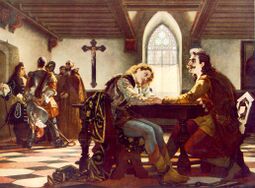
In 1664, the Austrian imperial army was victorious against the Turks, but Emperor Leopold failed to capitalize on the success when he signed the Peace of Vasvár in which Croatia and Hungary were prevented from regaining territory lost to the Ottoman Empire. This caused unrest among the Croatian and Hungarian nobility which plotted against the emperor. Nikola Zrinski participated in launching the conspiracy which later came to be known as the Magnate conspiracy, but he soon died, and the rebellion was continued by his brother, Croatian ban Petar Zrinski, Fran Krsto Frankopan and Ferenc Wesselényi. Petar Zrinski, along the conspirators, went on a wide secret diplomatic negotiations with a number of nations, including Louis XIV of France, the Polish–Lithuanian Commonwealth, Sweden, the Republic of Venice and even the Ottoman Empire, to free Croatia from the Habsburg sovereignty.[بحاجة لمصدر]
Imperial spies uncovered the conspiracy and on 30 April 1671 executed four esteemed Croatian and Hungarian noblemen involved in it, including Zrinski and Frankopan in Wiener Neustadt. The large estates of two most powerful Croatian noble houses were confiscated and their families relocated, soon after extinguished. Between 1670 and the revolution of 1848, there would be only 2 bans of Croatian nationality. The period from 1670 to the Croatian cultural revival in the 19th century was Croatia's political Dark Age. Meanwhile, with the victories over Turks, Habsburgs all the more insistent they spent centralization and germanization, new regained lands in liberated Slavonia started giving to foreign families as feudal goods, at the expense of domestic element. Because of this the Croatian Sabor was losing its significance, and the nobility less attended it, yet went only to the one in Hungary.[بحاجة لمصدر]
In the 18th century, Croatia was one of the crown lands that supported Emperor Charles's Pragmatic Sanction of 1713 and supported Empress Maria Theresa in the War of the Austrian Succession of 1741–48. Subsequently, the empress made significant contributions to Croatian matters, by making several changes in the feudal and tax system, administrative control of the Military Frontier, in 1745 administratively united Slavonia with Croatia and in 1767 organized Croatian royal council with the ban on head, however, she ignored and eventually disbanded it in 1779, and Croatia was relegated to just one seat in the governing council of Hungary, held by the ban of Croatia. To fight the Austrian centralization and absolutism, Croats passed their rights to the united government in Hungary, thus to together resist the intentions from Vienna. But the connection with Hungary soon adversely affected the position of Croats, because Magyars in the spring of their nationalism tried to Magyarize Croats, and make Croatia a part of a united Hungary. Because of this pretensions, the constant struggles between Croats and Magyars emerged, and lasted until 1918. Croats were fighting in unfavorable conditions, against both Vienna and Budapest, while divided on Banska Hrvatska, Dalmatia and Military Frontier. In such a time, with the fall of the Venetian Republic in 1797, its possessions in eastern Adriatic mostly came under the authority of France which passed its rights to Austria the same year. Eight years later they were restored to France as the Illyrian Provinces, but won back to the Austrian crown 1815. Though now part of the same empire, Dalmatia and Istria were part of Cisleithania while Croatia and Slavonia were in Hungarian part of the Monarchy.[بحاجة لمصدر]
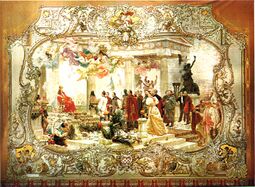
In the 19th century Croatian romantic nationalism emerged to counteract the non-violent but apparent Germanization and Magyarization. The Croatian national revival began in the 1830s with the Illyrian movement. The movement attracted a number of influential figures and produced some important advances in the Croatian language and culture. The champion of the Illyrian movement was Ljudevit Gaj who also reformed and standardized Croatian. The official language in Croatia had been Latin until 1847, when it became Croatian. The movement relied on a South Slavic and Panslavistic conception, and its national, political and social ideas were advanced at the time.[بحاجة لمصدر]
By the 1840s, the movement had moved from cultural goals to resisting Hungarian political demands. By the royal order of 11 January 1843, originating from the chancellor Metternich, the use of the Illyrian name and insignia in public was forbidden.
This deterred the movement's progress but it couldn't stop the changes in the society that had already started. On 25 March 1848, was conducted a political petition "Zahtijevanja naroda", which program included thirty national, social and liberal principles, like Croatian national independence, annexation of Dalmatia and Military Frontier, independence from Hungary as far as finance, language, education, freedom of speech and writing, religion, nullification of serfdom etc. In the revolutions of 1848 in the Austrian Empire, the Croatian Ban Jelačić cooperated with the Austrians in quenching the Hungarian Revolution of 1848 by leading a military campaign into Hungary, successful until the Battle of Pákozd.[بحاجة لمصدر]
Croatia was later subject to Hungarian hegemony under ban Levin Rauch when the Empire was transformed into a dual monarchy of Austria-Hungary in 1867. Nevertheless, Ban Jelačić had succeeded in the abolition of serfdom in Croatia, which eventually brought about massive changes in society: the power of the major landowners was reduced and arable land became increasingly subdivided, to the extent of risking famine. Many Croatians began emigrating to the New World countries in this period, a trend that would continue over the next century, creating a large Croatian diaspora.
Modern history (1918–present)
هذا القسم يحتاج المزيد من الأسانيد للتحقق. (November 2015) (Learn how and when to remove this template message) |
After the First World War and dissolution of Austria-Hungary, most Croats were united within the Kingdom of Serbs, Croats and Slovenes, created by unification of the short-lived State of SHS with the Kingdom of Serbia. Croats became one of the constituent nations of the new kingdom. The state was transformed into the Kingdom of Yugoslavia in 1929 and the Croats were united in the new nation with their neighbors – the South Slavs-Yugoslavs.
In 1939, the Croats received a high degree of autonomy when the Banovina of Croatia was created, which united almost all ethnic Croatian territories within the Kingdom. In the Second World War, the Axis forces created the Independent State of Croatia led by the Ustaše movement which sought to create an ethnically pure Croatian state on the territory corresponding to present-day countries of Croatia and Bosnia and Herzegovina. Post-WWII Yugoslavia became a federation consisting of 6 republics, and Croats became one of two constituent peoples of two – Croatia and Bosnia and Herzegovina. Croats in the Serbian autonomous province of Vojvodina are one of six main ethnic groups composing this region.[100]
Following the democratization of society, accompanied with ethnic tensions that emerged ten years after the death of Josip Broz Tito, the Republic of Croatia declared independence, which was followed by war. In the first years of the war, over 200,000 Croats were displaced from their homes as a result of the military actions. In the peak of the fighting, around 550,000 ethnic Croats were displaced altogether during the Yugoslav wars.[بحاجة لمصدر]
Post-war government's policy of easing the immigration of ethnic Croats from abroad encouraged a number of Croatian descendants to return to Croatia. The influx was increased by the arrival of Croatian refugees from Bosnia and Herzegovina. After the war's end in 1995, most Croatian refugees returned to their previous homes, while some (mostly Croat refugees from Bosnia and Herzegovina and Janjevci from Kosovo) moved into the formerly-held Serbian housing.[بحاجة لمصدر]
، صربيا، والجبل الأسود:
|
كاثوليك مسلمون أرثوذكس
|
پروتستانت كاثوليك وأرثوذكس مختلطون كاثوليك وپروتستانت مختلطون
|
الثقافة
الفن
By joining the Hungarian

العادات والتقاليد
الرموز

خرائط
انظر أيضاً
- قائمة الكروات
- شتات كرواتي
- أدب كرواتي
- تشيليون كروات
- أرجنتينيون كروات
- برازيليون كروات
- نمساويون كروات
- پيروڤيون كروات
- خط زمني للتاريخ الكرواتي
المراجع
ملاحظات
- ^ Bellamy, Alex J. (2003). The Formation of Croatian National Identity: A Centuries-Old Dream. Manchester, England: Manchester University Press. p. 116. ISBN 978-0-71906-502-6.
- ^ "Central Bureau of Statistics". Dzs.hr. Retrieved 2013-03-26.
- ^ Sarajevo, juni 2016. CENZUS OF POPULATION, HOUSEHOLDS AND DWELLINGS IN BOSNIA AND HERZEGOVINA, 2013 FINAL RESULTS (PDF). BHAS. Retrieved 30 June 2016.
- ^ خطأ استشهاد: وسم
<ref>غير صحيح؛ لا نص تم توفيره للمراجع المسماةdestatis - ^ "State Office for Croats Abroad". Retrieved 18 March 2015.
- ^ خطأ استشهاد: وسم
<ref>غير صحيح؛ لا نص تم توفيره للمراجع المسماةstatistik.at - ^ خطأ استشهاد: وسم
<ref>غير صحيح؛ لا نص تم توفيره للمراجع المسماةSerbianCensus - ^ خطأ استشهاد: وسم
<ref>غير صحيح؛ لا نص تم توفيره للمراجع المسماةadmin.ch - ^ "Présentation de la Croatie" (in French). Ministry of Foreign Affairs and International Development. Retrieved 28 June 2016.
{{cite web}}: CS1 maint: unrecognized language (link) - ^ خطأ استشهاد: وسم
<ref>غير صحيح؛ لا نص تم توفيره للمراجع المسماةstat.si - ^ "Hrvatsko iseljeništvo u Švedskoj" (in Croatian). Retrieved 18 March 2015.
{{cite web}}: CS1 maint: unrecognized language (link) - ^ خطأ استشهاد: وسم
<ref>غير صحيح؛ لا نص تم توفيره للمراجع المسماةnepszamlalas.hu - ^ خطأ استشهاد: وسم
<ref>غير صحيح؛ لا نص تم توفيره للمراجع المسماةistat.it - ^ "State Office for Croats Abroad". Retrieved 18 March 2015.
- ^ خطأ استشهاد: وسم
<ref>غير صحيح؛ لا نص تم توفيره للمراجع المسماةoecd.org - ^ خطأ استشهاد: وسم
<ref>غير صحيح؛ لا نص تم توفيره للمراجع المسماةmimmc.ro - ^ خطأ استشهاد: وسم
<ref>غير صحيح؛ لا نص تم توفيره للمراجع المسماةmonstat.org - ^ خطأ استشهاد: وسم
<ref>غير صحيح؛ لا نص تم توفيره للمراجع المسماةjoshuaproject.net - ^ "Population by immigrant category and country background". Statistics Norway. 1 January 2015. Retrieved 18 March 2015.
- ^ خطأ استشهاد: وسم
<ref>غير صحيح؛ لا نص تم توفيره للمراجع المسماةGlas Koncila - ^ "Croats of Czech Republic: Ethnic People Profile". czso.cz. Czech Statistical Office. Retrieved 17 April 2017.
- ^ Results American Fact Finder (US Census Bureau)
- ^ Farkas, Evelyn (2003). Fractured States and U.S. Foreign Policy. Iraq, Ethiopia, and Bosnia in the 1990s. Palgrave Macmillan US. p. 99.
- ^ Paquin, Jonathan (2010). A Stability-Seeking Power: US Foreign Policy and Secessionist Conflicts. McGill-Queen's University Press. p. 68.
- ^ Directory of Historical Organizations in the United States and Canada. American Association for State and Local History. 2002. p. 205.
- ^ Zanger, Mark (2001). The American Ethnic Cookbook for Students. Greenwood. p. 80.
- ^ Croatian diaspora in the USA It has been estimated that around 1.200.000 Croats and their descendants live in the USA.
- ^ "2011 National Household Survey: Data tables". Retrieved 18 March 2015.
- ^ أ ب ت ث ج ح خطأ استشهاد: وسم
<ref>غير صحيح؛ لا نص تم توفيره للمراجع المسماةcroata - ^ Diaspora Croata El Ministerio de Relaciones Exteriores de la República de Chile evalúa que en ese país actualmente viven 380.000 personas consideradas de ser de descendencia croata, lo que es un 2,4% de la población total de Chile.
- ^ "Hrvatsko iseljeništvo u Ekvadoru" (in Croatian). Retrieved 18 March 2015.
{{cite web}}: CS1 maint: unrecognized language (link) - ^ "State Office for Croats Abroad". Retrieved 18 March 2015.
- ^ خطأ استشهاد: وسم
<ref>غير صحيح؛ لا نص تم توفيره للمراجع المسماةabs.gov.au - ^ "7. Facts and figures – Dalmatians – Te Ara Encyclopedia of New Zealand". Retrieved 18 March 2015.
- ^ "Hrvatsko iseljeništvo u Novom Zelandu" (in Croatian). Retrieved 18 March 2015.
{{cite web}}: CS1 maint: unrecognized language (link) - ^ خطأ استشهاد: وسم
<ref>غير صحيح؛ لا نص تم توفيره للمراجع المسماةhic.hr - ^ خطأ استشهاد: وسم
<ref>غير صحيح؛ لا نص تم توفيره للمراجع المسماةethnologue.com - ^ أ ب خطأ استشهاد: وسم
<ref>غير صحيح؛ لا نص تم توفيره للمراجع المسماةdiasporas - ^ أ ب خطأ استشهاد: وسم
<ref>غير صحيح؛ لا نص تم توفيره للمراجع المسماةHWC - ^ خطأ استشهاد: وسم
<ref>غير صحيح؛ لا نص تم توفيره للمراجع المسماة:0 - ^ خطأ استشهاد: وسم
<ref>غير صحيح؛ لا نص تم توفيره للمراجع المسماة:1 - ^ "Croatian :: Ngati Tarara 'The Olive and Kauri'". croatianclub.org. Retrieved 2022-11-29.
- ^ Kapiteli, Marija; Taonga, New Zealand Ministry for Culture and Heritage Te Manatu. "Tarara Day". teara.govt.nz (in الإنجليزية). Retrieved 2022-11-29.
- ^ "European Commission – Frequently asked questions on languages in Europe". europa.eu.
- ^ "About BiH". Bhas.ba. Agency for Statistics of Bosnia and Herzegovina. Archived from the original on 11 July 2012. Retrieved 7 August 2019.
- ^ Gluhak, Alemko (1993). Hrvatski etimološki rječnik [Croatian Etymological Dictionary] (in الكرواتية). August Cesarec. ISBN 953-162-000-8.
- ^ Matasović, Ranko (2019), "Ime Hrvata" (in hr), Jezik (Croatian Philological Society) (Zagreb) 66 (3): 81–97, https://hrcak.srce.hr/228825?lang=en
- ^ Fine 1991, pp. 26–41.
- ^ Belošević, Janko (2000). "Razvoj i osnovne značajke starohrvatskih grobalja horizonta 7.-9. stoljeća na povijesnim prostorima Hrvata". Radovi (in الكرواتية). 39 (26): 71–97. doi:10.15291/radovipov.2231.
- ^ Fabijanić, Tomislav (2013). "14C date from early Christian basilica gemina in Podvršje (Croatia) in the context of Slavic settlement on the eastern Adriatic coast". The early Slavic settlement of Central Europe in the light of new dating evidence. Wroclaw: Institute of Archaeology and Ethnology of the Polish Academy of Sciences. pp. 251–260. ISBN 978-83-63760-10-6.
- ^ Bekić, Luka (2012). "Keramika praškog tipa u Hrvatskoj". Dani Stjepana Gunjače 2, Zbornik radova sa Znanstvenog skupa "Dani Sjepana Gunjače 2": Hrvatska srednjovjekovna povijesno-arheološka baština, Međunarodne teme. Split: Muzej hrvatskih arheoloških spomenika. pp. 21–35. ISBN 978-953-6803-36-1.
- ^ Bekić, Luka (2016). Rani srednji vijek između Panonije i Jadrana: ranoslavenski keramički i ostali arheološki nalazi od 6. do 8. stoljeća [Early medieval between Pannonia and the Adriatic: early Slavic ceramic and other archaeological finds from the sixth to eighth century] (in الكرواتية and الإنجليزية). Pula: Arheološki muzej Istre. pp. 101, 119, 123, 138–140, 157–162, 173–174, 177–179. ISBN 978-953-8082-01-6.
- ^ Bilogrivić, Goran (2018). "Urne, Slaveni i Hrvati. O paljevinskim grobovima i doseobi u 7. stoljeću". Zb. Odsjeka povij. Znan. Zavoda povij. Druš. Znan. Hrvat. Akad. Znan. Umjet. (in الكرواتية). 36: 1–17. doi:10.21857/ydkx2crd19. S2CID 189548041.
- ^ Dzino (2010, p. 175)
- ^ قالب:Harvard citation text
- ^ قالب:Harvard citation text
- ^ Dzino (2010, p. 20)
- ^ Budak, Neven (2008). "Identities in Early Medieval Dalmatia (7th – 11th c.)". In Ildar H. Garipzanov; Patrick J. Geary; Przemysław Urbańczyk (eds.). Franks, Northmen and Slavs: Identities and State Formation in Early Medieval Europe. Turnhout: Brepols. pp. 223–241. ISBN 9782503526157.
- ^ Dzino (2010, p. 186)
- ^ Wolfram (2002) Liudewit is considered the first Croatian prince. Constantine Porphyrogenitus has Dalmatia and parts of Slavonia populated by Croatians. But this author wrote more than a hundred years after the Frankish Royal annals which never mention the name of the Croatians although a great many Slavic tribal names are mentioned in the text. Therefore, if one applies the methods of an ethnogenetic interpretation, the Croatian Liudewit seems to be an anachronism.
- ^ Dvornik, F.; Jenkins, R. J. H.; Lewis, B.; Moravcsik, Gy.; Obolensky, D.; Runciman, S. (1962). P. J. H. Jenkins (ed.). De Administrando Imperio: Volume II. Commentary. University of London: The Athlone Press. pp. 139, 142.
- ^ Curta 2006, p. 210.
- ^ Budak, Neven (1994). Prva stoljeća Hrvatske (PDF). Zagreb: Hrvatska sveučilišna naklada. pp. 58–61. ISBN 953-169-032-4. Archived from the original (PDF) on 4 May 2019. Retrieved 13 July 2022.
- ^ Gračanin, Hrvoje (2008), "Od Hrvata pak koji su stigli u Dalmaciju odvojio se jedan dio i zavladao Ilirikom i Panonijom: Razmatranja uz DAI c. 30, 75-78" (in hr), Povijest U Nastavi VI (11): 67–76, https://hrcak.srce.hr/36767?lang=hr
- ^ قالب:Harvard citation text
- ^ Živković, Tibor (2006). Portreti srpskih vladara (IX—XII vek). Belgrade: Zavod za udžbenike. pp. 60–61. ISBN 86-17-13754-1.
- ^ Živković, Tibor (2012). "Неретљани – пример разматрања идентитета у раном средњем веку" [Arentani – an Example of Identity Examination in the Early Middle Ages]. Istorijski časopis. 61: 12–13.
- ^ Dvornik 1962, p. 139, 142.
- ^ Fine 1991, p. 37, 57.
- ^ Heather, Peter (2010). Empires and Barbarians: The Fall of Rome and the Birth of Europe. Oxford University Press. pp. 404–408, 424–425, 444. ISBN 978-0-19-974163-2.
- ^ Dvornik 1962, p. 138–139.
- ^ Dvornik, Francis (1970). Byzantine Missions Among the Slavs: SS. Constantine-Cyril and Methodius. New Brunswick, New Jersey: Rutgers University Press. p. 26. ISBN 9780813506135.
Constantine regards all Slavic tribes in ancient Praevalis and Epirus—the Zachlumians, Tribunians, Diodetians, Narentans— as Serbs. This is not exact. Even these tribes were liberated from the Avars by the Croats who lived among them. Only later, thanks to the expansion of the Serbs, did they recognize their supremacy and come to be called Serbians.
- ^ Živković 2006, pp. 60–61.
- ^ "Neretljani". Hrvatski obiteljski leksikon (in الكرواتية). Retrieved 12 December 2017.
- ^ قالب:Harvard citation text
- ^ أ ب ت ث قالب:Harvard citation text
- ^ Fine 1991, p. 257.
- ^ Fine 1991, p. 261.
- ^ Hrvatski leksikon (1996–1997) (in كرواتية)[استشهاد ناقص]
- ^ Stjepan Antoljak, Pregled hrvatske povijesti, Split 1993., str. 43.
- ^ "Kralj Tomislav". Hrvatski vojnik (in الكرواتية). 2018-11-30. Retrieved 2020-05-27.
- ^ Evans, Huw M. A. (1989). The Early Mediaeval Archaeology of Croatia, A.D. 600–900 (in الإنجليزية). B.A.R. ISBN 978-0-86054-685-6.
- ^ Bonifačić, Antun; Mihanovich, Clement Simon (1955). The Croatian nation in its struggle for freedom and independence: a symposium (in الإنجليزية). "Croatia" Cultural Pub. Center.
- ^ De Administrando Imperio, Byzantine Emperor Constantine VII Porphyrogenitos, 950
- ^ Vedriš, Trpimir (2007). "Povodom novog tumačenja vijesti Konstantina VII. Porfirogeneta o snazi hrvatske vojske" [On the occasion of the new interpretation of Constantine VII Porphyrogenitus'report concerning the strength of the Croatian army]. Historijski zbornik (in الكرواتية). 60: 1–33. Retrieved 29 July 2020.
- ^ Budak 2018, pp. 223–224.
- ^ Bakalov, Istorija na Bǎlgarija, "Simeon I Veliki"
- ^ Omrčanin, Ivo (1984). Military history of Croatia. Dorrance. p. 21. ISBN 978-0-8059-2893-8. Retrieved 29 April 2012.
- ^ Royal Anthropological Institute of Great Britain and Ireland; JSTOR (Organization) (1882). Journal of the Royal Anthropological Institute of Great Britain and Ireland. The Institute. Retrieved 29 April 2012.
- ^ (in كرواتية) PETAR KREŠIMIR IV.TRPIMIROVIĆ
- ^ Dominik Mandić, Rasprave i prilozi iz stare hrvatske povijesti, Institute of Croatian history, Rome, 1963., page 315., 438.
- ^ "18. Slavac – Dmitar Zvonimir" (PDF). 13 March 2012. Archived from the original (PDF) on 13 March 2012. Retrieved 12 December 2017.
- ^ "Demetrius, Duke of Croatia and Dalmatia". Archived from the original on 2006-02-12.
- ^ Raukar, Tomislav (1997). Hrvatsko srednjovjekovlje: prostor, ljudi, ideje. ISBN 978-953-0-30703-2.
- ^ "Croatia". Encyclopædia Britannica. Retrieved 18 March 2015.
- ^ Curta, Stephenson, p. 267
- ^ "Full text of "The southern Slav question and the Habsburg Monarchy"". Archive.org. Retrieved 18 March 2015.
- ^ Charles W. Ingrao (2000). The Habsburg Monarchy, 1618–1815. Cambridge University Press. p. 15. ISBN 978-0-521-78505-1.
- ^ Catholic Encyclopedia
- ^ "Vlada Autonomne Pokrajine Vojvodine – Index". Vojvodina.gov.rs. Archived from the original on 12 February 2012. Retrieved 17 February 2012.
وصلات خارجية
- قالب:Hr icon Matica hrvatska
- Review of Croatian History at Central and Eastern European Online Library
- Croats of Bosnia and Herzegovina: History
- The Croatian nation at the beginning of the 20th century
- Famous Croats and Croatian cultural heritage
- Croatian Heritage Foundation Hrvatska matica iseljenika
- Croatians in Arizona
- CS1 الكرواتية-language sources (hr)
- Articles with كرواتية-language sources (hr)
- Articles with incomplete citations from November 2014
- All articles with incomplete citations
- "Related ethnic groups" needing confirmation
- Articles using infobox ethnic group with image parameters
- Articles containing كرواتية-language text
- Articles containing Medieval Latin-language text
- Articles with text in West Slavic languages
- Articles containing Greek-language text
- Lang and lang-xx code promoted to ISO 639-1
- Articles with hatnote templates targeting a nonexistent page
- Articles needing additional references from November 2015
- All articles needing additional references
- Articles with unsourced statements from November 2015
- Articles with unsourced statements from October 2021
- المقالات needing additional references from November 2015
- كل المقالات needing additional references
- كروات
- مجتمع كرواتي
- قوميات سلاڤية

